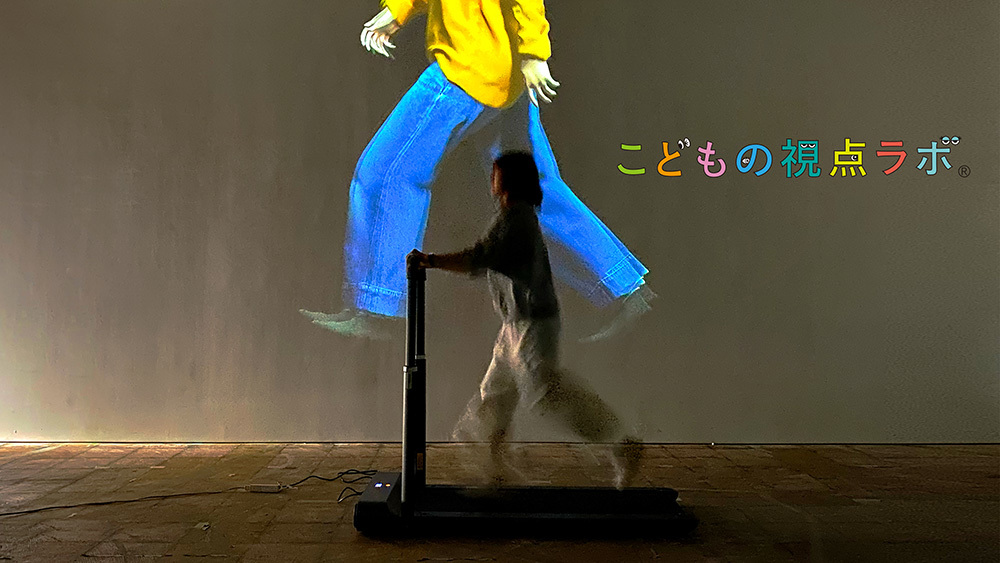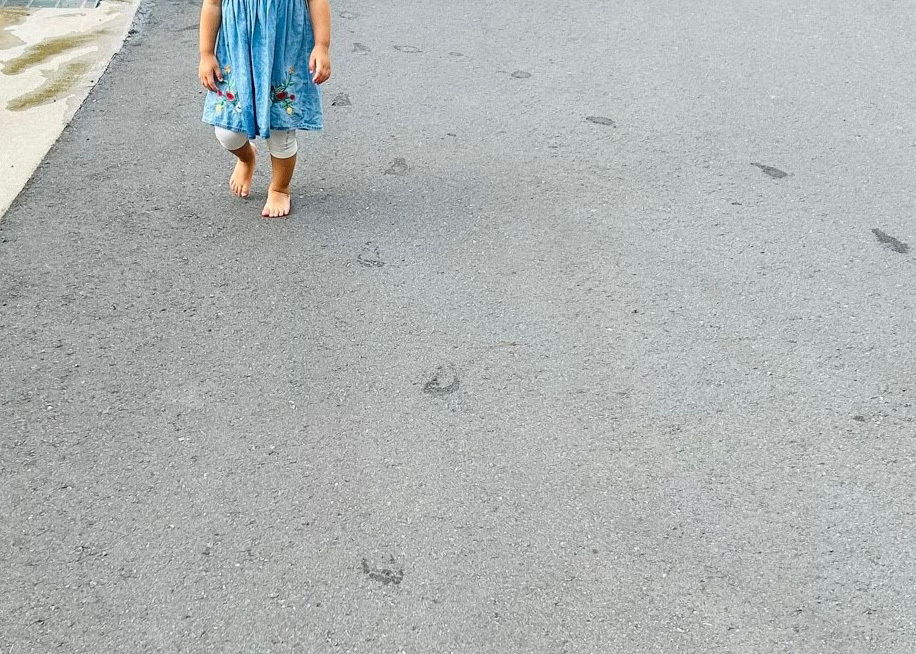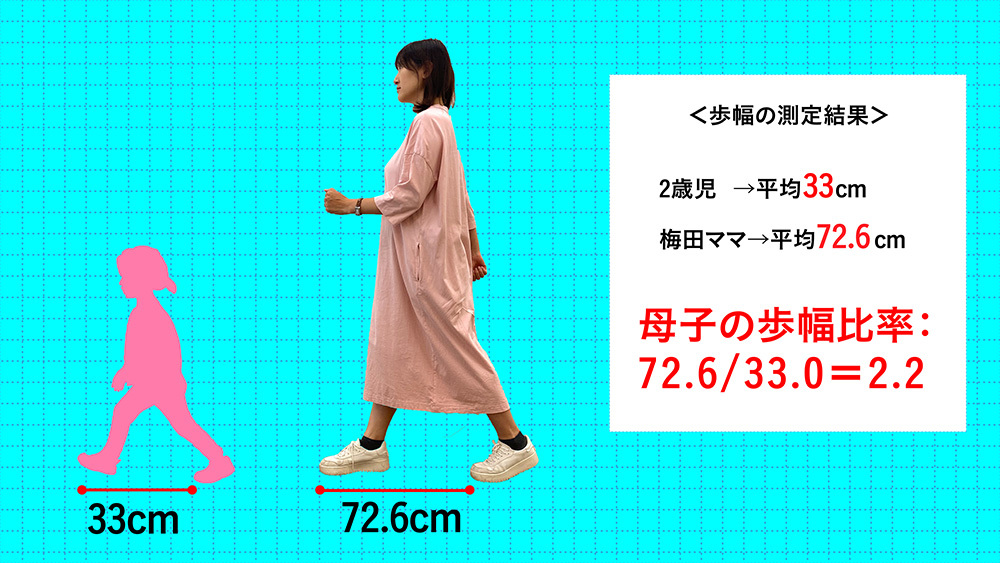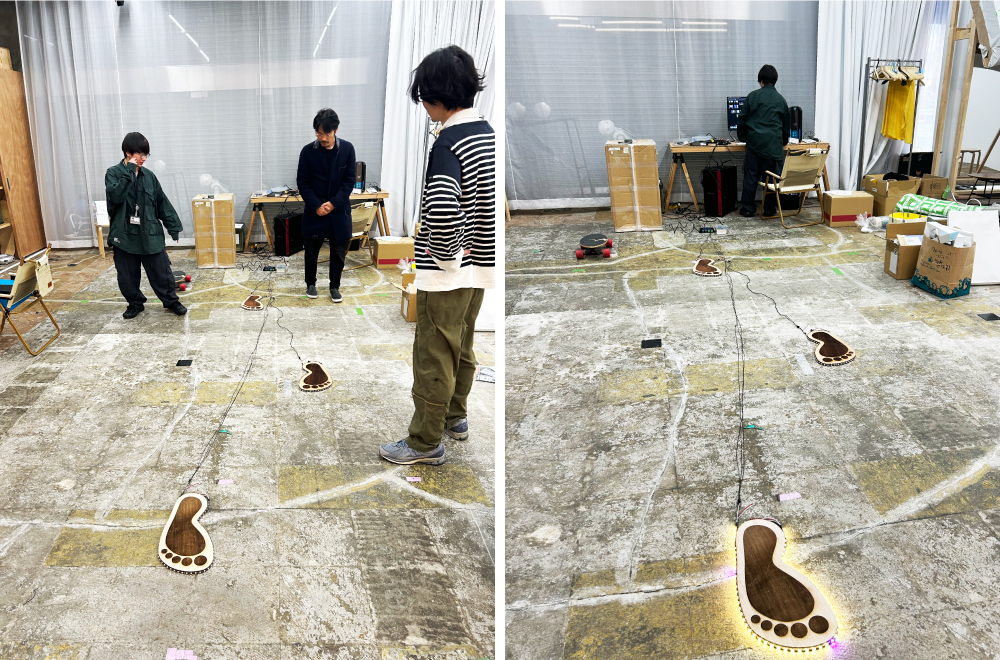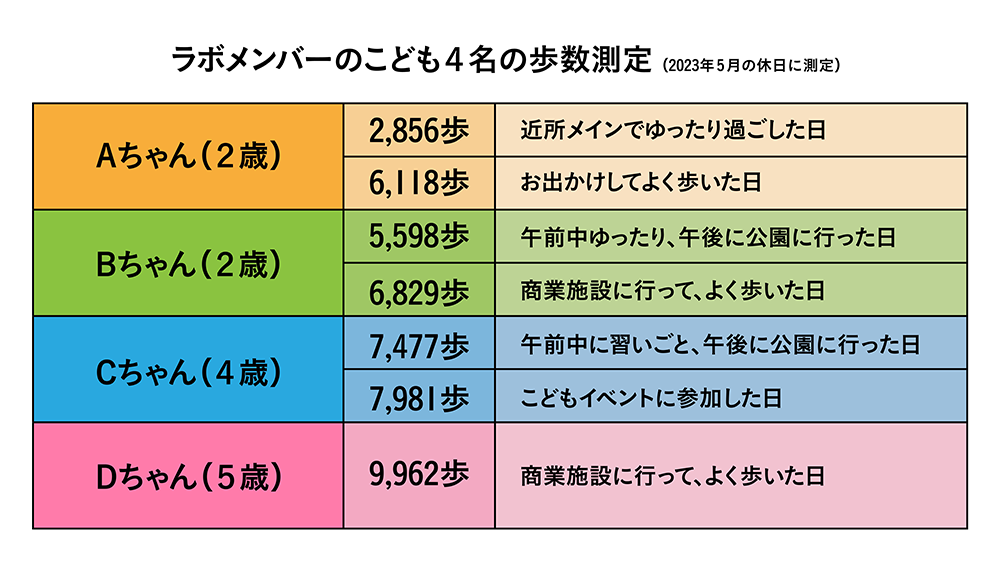When walking with my child, we barely make any progress.
They constantly stop, crouch down, pick things up, or pluck leaves. Telling them, "Let's hurry to the park!" or "We'll be late for our plans!" doesn't make them rush. You start wondering when you'll ever reach your destination... and it feels like it'll take forever. Many moms and dads have probably experienced getting increasingly frustrated and finally urging, "Come on, hurry up!"
Previously, students from the Seki Seminar at Ueda Women's Junior College, who created our lab's research for a cultural festival, devised a "Child's Stride Experience" based on the idea that "Adults and children have different stride lengths. So we need to adjust to theirs." Lab member Fumiko Ishida tried out this activity, where both feet are tied together with knitted yarn to narrow the stride ( Child's Perspective Lab No.8 ).
We often find ourselves thinking, "Walk faster!" But what if children are actually trying their hardest to walk quickly? This made us decide to research "children's stride length" at the lab.
Adult stride length was about 2.2 times that of a 2-year-old!
Since we couldn't find existing data on "toddler stride length," we started by measuring it ourselves. The subjects were lab member Makiko Umeda and her daughter T-chan (2 years and 2 months old). To encourage natural walking, we used a method where we wet the soles of their bare feet with water and measured the footprints.
Stride measurement results: 2-year-old → Average 33cm
Mom Umeda → Average 72.6cm   ; (Calculated as the average of 5 steps for both)
We also measured two female lab members of similar height (around 160cm) and two 2-year-olds, confirming no significant error. We decided to adopt the Umeda family's results.
An adult's stride length is a whopping 2.2 times that of a 2-year-old! Just seeing the numbers made it painfully clear how much we're asking of children. So, what would it actually feel like for an adult to become a child and experience a 2.2 times larger stride? Creative Technologist Ryunosuke Ono created the "Child's Stride Experience."
Visualizing an adult foot and a 2.2 times larger stride
First, we cut large footprint shapes from wood using a laser cutter and wrapped tape LEDs around them to create "adult feet." We then placed these "adult feet" at intervals 2.2 times the average stride length mentioned earlier. We programmed them so the light progressed in the walking direction, assuming each step took 0.7 seconds. We created a demo where giant adult footprints appeared to walk by glowing. Staff members playing the role of children walked simultaneously from the starting point.
This experiment showed that keeping up with an adult seems quite challenging, but it still didn't feel real. To truly experience it, walking a much longer distance would be necessary. However, creating a long-distance version of this device would be quite large-scale, so we decided to explore another method.
Shocking! Even when an adult walks slowly, it's 7.7 km/h for a child!?
So, we used a treadmill to measure Ms. Umeda's normal walking speed again. We decided to multiply that by 2.2.
Natural walking speed alone: 4.0 km/h × 2.2 = 8.8 km/h
Speed when trying to walk slowly to match a child: 3.5 km/h × 2.2 = 7.7 km/h
※We also measured two other female lab members and confirmed the same speed perception with no difference.
Wait, even when I think I'm walking slowly to match the child, it's 7.7 km/h for them!? I thought it was just brisk walking, but it's actually running speed!
Next, we projected a giant adult walking figure onto the projector. We conducted the "2-Year-Old WALK" experiment, where participants followed the figure's back to experience walking at 7.7 km/h. And it came with "hurry up" lines like: "Come on, faster, faster!" "Hey, hurry up. Can't you walk a bit faster?" "Hurry up, I'm leaving you behind!" Seeing the relentless back of the mom marching on, despite trying so hard to keep up... it made me want to cry. Within just a few minutes, it was "This might be tough," "Could we please stop for a moment?"
If walking slowly feels this fast to an adult, imagine how fast it must be when Mom speeds up saying "The train's coming! Hurry!" or when trying to keep up with Dad, who's taller and has a longer stride?
By the way, the standard for real estate listings showing "walking distance from station" is "1 minute walk = 80m road distance," which equates to walking at 4.8km/h. Multiply that by 2.2 and you get 10.56km, which is roughly 11km/h!! No way, no way, no way. We actually tried running at 11 km/h on a treadmill, and it was practically full speed. Some members nearly stumbled and fell. Dangerous!! Asking children to keep up with adult speeds is definitely an impossible game for them.
Armed with these results, Fumiko Ishida and Ryunosuke Ono spoke remotely with Professor Saori Tanaka of Kyushu Sangyo University, who conducts various research on physical activity and exercise in infants and young children.
Is it normal for kids to stop every 10 steps!?
Axe: Professor Tanaka, thank you for joining us. You research young children's walking in real-life and childcare settings. What are your thoughts on the "Walk at 2" walking experience conducted by the Children's Perspective Lab?
Professor Tanaka (hereafter, Professor): It's a very interesting and intriguing experiment. First, regarding measuring footprints made in wet water. Children's stride length changes significantly depending on where they walk, so I thought it was excellent that it was measured in a natural environment. However, toddlers actually walk much, much slower, right?
Axe: Meaning?
Professor: Children stop frequently, don't they? It feels like they stop once every ten steps or so. Just when you think they're moving forward, they might turn back.
Ishida: That's definitely true.
Professor: So, if we don't factor in child-specific traits like "stopping" or "backtracking," I think this experiment captures an average speed. Intuitively, I'd say the stress-free walking speed for an adult accompanying a child is around 3 to 3.5 km/h.
Ishida: In reality, if you try to match a child's pace at around 3.5 km/h, you'd end up stopping to wait for them, then starting again, right?
Professor: Exactly. So in reality, children probably perceive "adult walking" as much faster. Unlike adults, children see so many things they want to look at while walking.
Axe: Just walking around the neighborhood?
Teacher: Yes. For example, there's this experiment. When adults were shown a picture of a chimpanzee, they stopped looking the moment they recognized it. Their gaze just stopped moving. But when infants were shown the same picture, they kept staring intently, trying to make out the chimpanzee's face. (※1)
※1: Olivier Pascalis, Michelle de Haan, Charles A Nelson, ‘Is face processing species-specific during the first year of life?,’ DOI: 10.1126/science. 1070223 https://pubmed.ncbi.nlm.nih.gov/12016317/
Adults lose interest the moment they recognize something as a tree or a leaf, but for children, those things are objects of fascination. So, children are looking at things that aren't ordinary to them, wondering "What is that?" with genuine interest. Yet, they get dragged away while still holding onto that feeling. In that sense, I think from a child's perspective, "adult walking" must feel much faster.
Ishida: I see! It's true that things adults take for granted aren't necessarily commonplace for children. That was quite the blind spot.
Teacher: Even adults dislike being rushed when they find something they want to look at, right?
Axe: Based on your experience researching toddlers, is the pace you mentioned earlier—like stopping once every 10 steps—typical?
Professor: It depends on age and environment, but for the two-year-olds in our experiments, that's how it feels. Also, a distance an adult can cover in five minutes takes them about twenty minutes.
Ishida:So moving with kids takes four times as long! Yeah, my own kid was exactly like that. It took about 40 minutes to get to the nursery school that should have taken 10. Sometimes it actually took over an hour, and I was the one crying (laughs).
Teacher: I bet. When they're sleepy and cranky, they really won't move.
Ishida: But like you said, if you keep in mind from the start that "kids stop every 10 steps" and "a 5-minute walk takes 20 minutes," it helps you prepare mentally.
Teacher: That's right. Once you've experienced it like you have, Ishida-san, you can handle it emotionally. But I understand how it increases parental stress with a first child.
On the other hand, children's walking distance has drastically decreased to less than 50% of what it used to be!
Axe: In your paper, you mentioned being concerned about the decline in children's walking. Our lab measured the step counts of young children too—would you like to see the results?
We had four children of lab members wear small pedometers and measured their steps on their days off. What do you think about these step counts?

Professor: I think these are fairly reasonable figures for modern walking levels. Based on my data measuring walking from 9 AM to 4 PM at daycare centers, children aged 3, 4, and 5 typically averaged around 6,000 steps. If a 5-year-old exceeded 10,000 steps, it felt like, "Wow, they really put in the effort." For 2-year-olds, it was a bit less, averaging around 3,000 to 4,500 steps. However, more active children walked significantly more, and the individual variation was greater among younger children.
Axe: Do you have data on how children's walking amounts change over time?
Professor: We have data for elementary school children. In the 1970s and 80s, the average was around 20,000 to 27,000 steps. Twenty years later, the average dropped to about 10,000 steps, roughly a 50% decrease. Now, another 20 years later, children's walking and activity levels continue to show a declining trend. (※2)
※2: Hatanaka, Yoshiro (1979). How Many Steps Does a Person Walk in a Day? "Science of Physical Education" 29(1), 28-31.
Kazuhiko Nakamura (2004) "Children's Bodies Are in Danger! Building Bodies Starting Today," Nihon Hyōjun.
Satoshi Hanawa, Shingo Noi (2018). An Attempt at Step Count Indicators by Intensity to Secure Target Physical Activity Time for Elementary School Students, "Research on Growth and Development" (78), 13-23.
Ishida: Half! Has it really decreased that much? So, are toddlers' step counts decreasing too? Nowadays, they're often carried in baby carriers or pushed in strollers.
Teacher: I definitely think it's decreased. Beyond baby carriers, strollers, and car travel, you see baby carts everywhere in commercial facilities now too.
Axe: What kind of impact does this decrease in children's walking and activity levels have?
Professor: Activity levels are important, but first, it's widely recognized that "long periods of sitting are problematic." Avoid keeping children fixed in one place for over an hour. Unlike adults, children don't separate daily life from physical activity. Reduced activity directly translates to fewer experiences and learning opportunities. This can lead to difficulties in communication, impaired cognitive development—essentially, a lack of experience.
Axe: So spending too much time just sitting and watching can actually affect their development?
Teacher: Yes. Have you heard of the Held and Hein experiment? It's an experiment conducted by scholars Held and Hein on the relationship between kittens' vision and physical abilities. (※3)
They raised kittens born at the same time under identical visual conditions: one kitten was placed in a ride (vehicle), while the other was allowed to move freely on the floor. When the kitten raised in the ride was taken out and made to walk, it couldn't avoid obstacles. In contrast, the kitten that moved freely could skillfully avoid obstacles. This demonstrates that passive visual experience does not contribute to physical abilities.
Exposure to passive visual information thus diminishes proactive behavior. Without the experience of walking on their own feet, even if scenery appears before them, they cannot understand things like "moving this much will cause a collision" or even recognize "what I'm seeing now is an obstacle."
※3: Held & Hein, ‘Movement-produced stimulation in the development of visually guided behavior,’ Journal of Comparative and Physiological Psychology, 56(5), 872–876. , 1963
Ishida: So, if babies are always in strollers or cars, they can't grasp distances to objects and their reflexes don't develop?
Teacher: Exactly. It hinders not only physical abilities but also the development of initiative.
Ishida: That's... scary. My child initially refused the stroller, making trips to daycare a struggle. But one day, they suddenly decided to try it. Honestly, after that, I pretty much kept them in it all the time...
Axe: Speaking of passive visual experiences, screen time with smartphones and tablets is also increasing these days. That probably means they're sitting still a lot too.
Teacher: Exactly. Moving around a lot can be rephrased as having an interest in many things. Wanting to touch that, wanting to play with that. It's like an "antenna of interest" – the more curiosity they have about the outside world, the more their mental activity increases.
Ishida: I think it should be more widely known that simply letting children move freely is itself an experience and a form of learning.
Axe: In your research materials, I read that "children aged 1 to 2 need at least 3 hours of physical activity per day."
Ishida: Huh, three hours of activity? Isn't that quite demanding?
Professor: It means they should be active for about 3 hours a day, regardless of the intensity of the activity. Even walking to the bathroom counts as activity. However, when we measured activity levels at several daycare centers, some weren't even reaching this 3-hour mark.
Axe: It also says the more physical activity, the better.
Teacher: Yes. Children who were actively moving around daily around age 2 tend to have well-developed core strength. Conversely, in my experience , children who can't sit still or slump when seated by age 5 or 6 often had a history of not walking much or disliking exercise around age 2. They're also more prone to developing floating toes. There's a tendency for their toes not to touch the ground, making it hard for them to properly plant their feet.
Ishida: Oh my! So they can't sit properly because they haven't built up their abdominal muscles or core strength, and their floating toes lead to poor walking and posture? Oh no! My child is in elementary school now, but they slump over immediately when sitting!
Teacher: Since activity levels around ages 1-2 tend to affect development after age 3, it's hard for parents to notice these early signs.
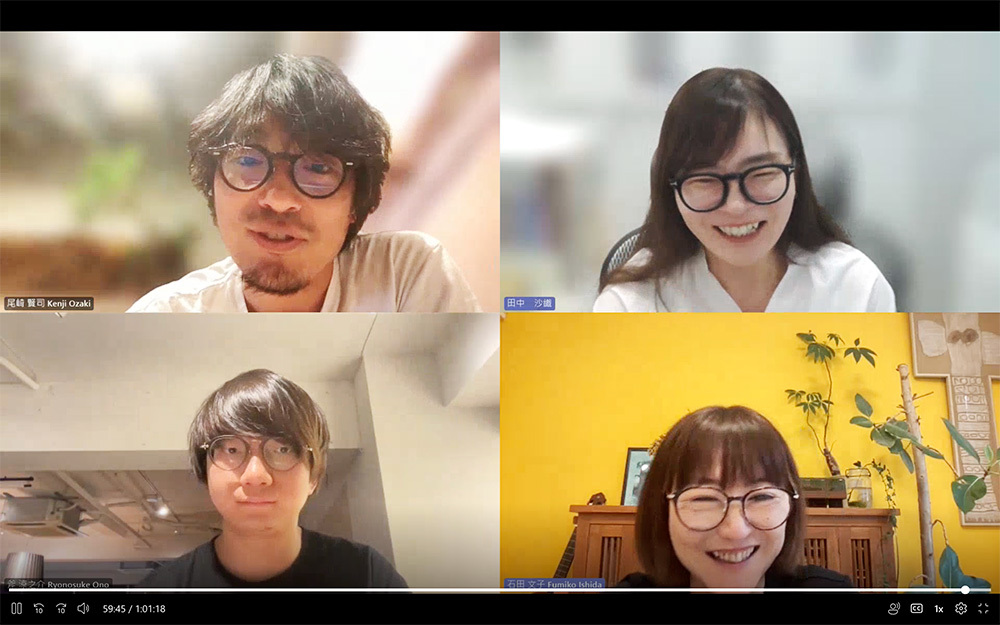
Remote interview with Tanaka Sensei
Just like meals, exercise can be balanced out over a week
Axe: But you mentioned that from around age 3, it's better to have at least 60 minutes of high-intensity exercise per day.
Ishida: That sounds pretty tough, doesn't it? Many parents today are dual-income and already busy, feeling stretched thin every day. If it were me, I'd probably think, "Huh? Make them exercise 60 minutes every day? Are you telling me to push myself even harder?"
Professor: I understand. But you don't need to think, "I have to get them to exercise 60 minutes every single day." It's fine to balance it out over a week. With food, if you eat too much one day, you think about eating a little less the next day, right? With exercise, I think it's good to be flexible and think, "We didn't move much during the week, so let's play together a lot on the weekend."
Axe: I see.
Teacher: It really helps to think about it alongside your daily rhythm. If you eat too little or stay up late, you won't have the energy to move in the morning.
Ishida: So, if you go to bed early, wake up early, and eat well, you'll have the energy to move around. And you can balance out the exercise over the course of a week. Thinking about it that way makes it seem doable.
Teacher: For example, deciding specific areas or times to walk, like "We'll walk from the parking lot to daycare" or "We'll walk to the park," is also recommended. Also, when your child stops and shows interest in something, think of it as them gaining new experiences. Just think, "Ah, my child is getting smarter right now!" I think that will reduce your stress even more.
Ishida: I see! Instead of "Ugh, they stopped again," think "My child is getting smarter right now!" That's absolutely brilliant. If I'd thought that way, I could have been more patient with my child. Man, I wish I'd known all this when my kids were little.
Axe: Thank you so much, Dr. Tanaka!
Now, let's summarize this session.
● An adult's stride is about 2.2 times longer than a 2-year-old's! Walking at an adult's pace might feel like over 7.7 km/h to a child, so remember they're really trying hard to keep up.
● It's normal for kids to stop once every 10 steps. What takes an adult 5 minutes might take them 20. Plan outings with this in mind to reduce frustration.
● When a child stops to show interest in something, they're gaining new experiences. Think, "My child is getting smarter right now!" and try to wait patiently (when you can).
● Children aged 1-2 should have at least 180 minutes of physical activity daily. Avoid sitting for over an hour at a time. If you think, "Did we move enough this week?", make sure to play a lot on your day off!
When my child was little, I wanted to enroll them in various classes for emotional development and take them to many places. But I realized I might have been rushing them to stop what they were actually experiencing and learning right then, just for the sake of what adults consider "experiences and learning." That felt like putting the cart before the horse, and I felt terribly sorry. Of course, use strollers or shopping carts when you're busy, but when you have the time, I think it's better not to prioritize getting to your destination quickly. Instead, enjoy walking together, valuing your child's pace!



